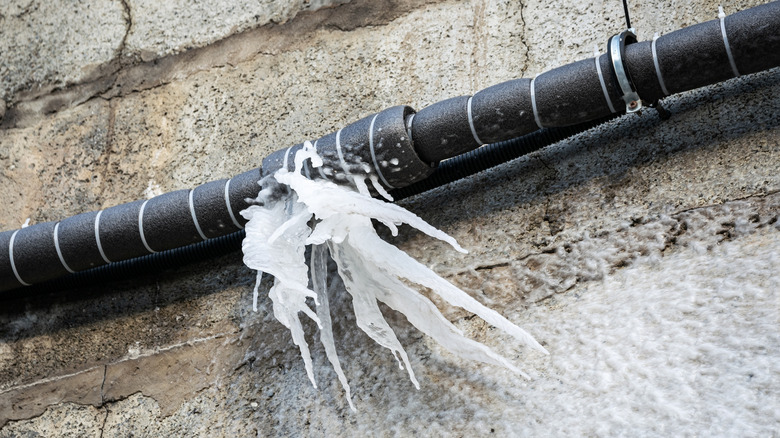How Long It Takes The Pipes In Your Home To Freeze In The Cold Weather
From lightly frosted windows to sparkling snow blanketing the trees, winter brings plenty of charm to town when you love the cold. But behind the cozy task of filling up your kettle to make something warm to drink lies a hidden threat many homeowners don't notice until it's too late. Frozen pipes don't just push pause on your cup of tea or hot chocolate. Building over hours, water inside your home's pipes slowly stops moving until it finally solidifies. It's not just about your faucet's flow turning into a steady drip. The water expands as it freezes, pushing hard against the pipe walls. That pressure can be enough to crack or even burst them. By understanding how and why pipes freeze, and how long it takes to happen, homeowners can stay one step ahead of the plumbing nightmare.
There is no universal timeline for how long it takes the pipes in your home to freeze because a variety of factors is involved. Along with the material and diameter of your pipes, the surrounding insulation, exposure to wind, and ambient temperature all matter. For example, thin copper pipes in uninsulated exterior walls freeze much faster than thick plastic ones tucked deep in your home's interior.
A rapid drop to freezing temperatures makes the water in your pipes freeze quickly, while sustained temperatures just below 32 degrees Fahrenheit will make ice formation take much longer. Drafts, the wind chill, and nearby moisture can shorten the timeline, turning a slow freeze into an urgent situation. Understanding these conditions is the key to predicting (and preventing) the dreaded scenario.
Tips and tricks for preventing frozen pipes
During a mild freeze, with overnight temperatures just below 32 degrees Fahrenheit, pipes may take 12 hours or more to solidify. If you expect these conditions, keep your pipes from freezing by letting your faucets drip or opening your cabinet doors to surround them with a little more ambient warmth. In a moderate freeze, with temperatures between 10 and 20 degrees Fahrenheit, exposed pipes can freeze in four to six hours. Along with running a trickle of warm water, there are several useful products to prevent your pipes from freezing during winter, like foam or heat tape.
During extreme freezes in any weather below 10 degrees Fahrenheit, you'll need to move quickly. Especially if wind is beating against exterior walls that house your pipes, solid ice can form in as little as two hours. In these cases, your best bet is to leave your faucets running with warm water and use portable heat sources near the pipes to surround them with as much ambient warmth as possible.
If your pipes do freeze, don't panic. First, turn off your home's main water supply valve. If you can't find it, call your utility company for help. Then, look for visible frost on the outside of any pipes in your basement, in the attic, and under sinks. Once you've located the frozen culprit, slowly open the connected faucets to relieve any pressure buildup. In the event you see any leaking, cracking, or burst pipes, call a professional plumber. But if your pipes are intact, use a hair dryer to gently thaw the frozen areas.

